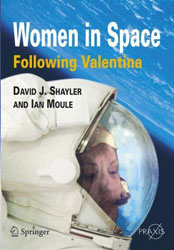
Being female makes for some basic biological differences. But as proven time and again, women have proven themselves capable to undertake and satisfactorily complete the same tasks as done by men. Given that piloting vehicles is less about strength and more about coordination and intuition, some would happily wager that women should excel in this role. However, because flight grew up as a tool of war and war has been a strictly male domain, women have always been at the periphery looking in. The insipient space industry also arose from a military foundation, hence, again men made decisions and prepared designs for themselves. Thus, though many women had the capability and desire to contribute, few opportunities arose for their participation in space.
Even though much could be said on the participation, or lack thereof, of women in space, Shayler and Moule’s book focuses solely on the achievements. The little seagull, Valentina Tereshkova, was the first woman to fly into space, but predecessors abounded. In acknowledging this, Shayler and Moule take the reader on a history lesson. They go to the 1700’s, when women astronomers were making their mark by flying in Montgolfier styled balloons. Parachuting, gliding and powered flight quickly succumbed to their skills. As most of these accomplishments could be achieved by an individual, women could and did do as they wished. This history review, though brief, amply demonstrates the ability of women.
In a juxtaposition, the book shows how, once society’s morality came into play, women were no longer equal players. That is, they were involved because of their sex, principally shown by the USSR in their program. The authors, however, stay with the facts by noting cosmonaut selection and training. After providing the backgrounds of many of these hopefuls, and the successful Valentina herself, Shayler and Moule switch back to the program of the United States. In an attempt to be broadly inclusive or perhaps to fill in a sorry lack of participation, they broaden their extent of achievements. There’s the female computers doing orbital trajectories as well as seamstresses who sewed flight suits and Skylab’s reflector. However, in using old phone books for identification, the authors let slip the narration and in consequence the book transposes into a series of lists rather than a discussion of accomplishments.
For example, much is made of Nichelle Nichols, better known as Uhura of Star Trek fame. True, she was prominent in early outreach programs for females but she did not directly contribute. There’s also description of the families and spouses of male astronauts. It wasn’t until the space shuttle era that women entered the mainstream. Sadly, here again, the authors trivialize their work by filling up much of the remainder of the book with data sheets. Using NASA Query Book and Press Kit factoids, they list every female who has flown on the space shuttle (or Soyuz), their technical background and their mission tasks. They go so far as identifying which shuttle seat they occupied during launch and return. Listing of minor roles, such as organizing flight shirts, clearly shows that the authors let NASA’s dogma dictate the contents. They neglect their own narrative abilities, which they ably showed in the earlier chapters.
By staying narrowly focussed on achievements, the author’s missed writing a great book rather than the good book they did write. They should have surmised on the precepts of a society that kept females in support roles while men achieved the glory. They alluded to but did not support the premise that shuttle crews would no longer include females so society would grieve less should another disaster occur. Does this mean men are more expendable? Sadly, their book never rises to this occasion.
There is no doubt that in most fields women are every bit as capable as men. The aerospace frontier is no exception. Women in Space by David Shayler and Ian Moule lists the women and their achievements as they and space flight increased in capability. From flying in balloons to piloting the space shuttle, they’re all in this book with great praise to their contributions.
Review by Mark Mortimer
Read more reviews online, or purchase a copy from Amazon.com.
